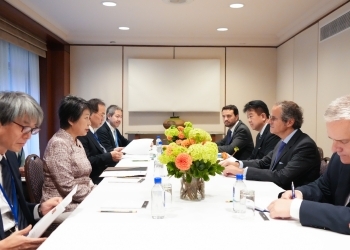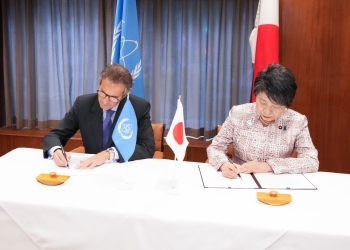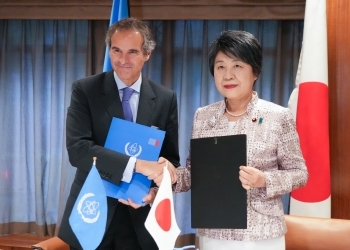Atomic Energy
Meeting between Foreign Minister Kamikawa and H.E. Mr. Rafael Mariano Grossi, Director General of the the International Atomic Energy Agency and Signing Ceremony of Memorandum of Cooperation
September 18, 2023



On September 18th, commencing at 5:00 p.m. local time (6:00 a.m. JST) for approximately 30 minutes, Ms. Kamikawa Yoko, Minister for Foreign Affairs of Japan, who is visiting New York to attend the United Nations General Assembly session, signed the Memorandum of Cooperation between Japan and the IAEA concerning ALPS treated water and held a meeting with H.E. Mr. Rafael Mariano Grossi, Director General of the International Atomic Energy Agency. The overview is as follows.
- At the outset, Foreign Minister Kamikawa and Director General Grossi signed the Memorandum of Cooperation between Japan and the IAEA on IAEA Monitoring and Assessment Activities concerning the ALPS-Treated Water Discharges at the Fukushima Daiichi Nuclear Power Station. Foreign Minister Kamikawa stated that this memorandum reaffirms Japan’s cooperation with the IAEA such as the its continued review and monitoring and will further contribute to enhancing the international community's confidence in the safety.
- Foreign Minister Kamikawa appreciated that the IAEA has been checking the monitoring data in real time and publishing them in a highly transparent manner, while almost one month passing since the start of the discharge of ALPS treated water into the sea. Furthermore she stated that Japan will continue to explain the safety of ALPS treated water both domestically and internationally in a highly transparent manner based on scientific evidence and to work closely with the IAEA on this matter.
- In response, Direcor General Grossi, introducing that the Memorandum is a further step forward in the cooperation with Japan on ALPS treated water that began two years ago, stated that IAEA will ensure to the international community that the discharges are being carried out as planned consistent with IAEA safety standards and explain it in transparent manner based on sceintifc perspective.
- Director General explained the IAEA initiatives such as “Atoms4Food” and appreciated Japan’s cooperation on IAEA’s works for the peaceful uses of nuclear energy.
(Reference)Memorandum of Cooperation (MOC) between the Government of Japan and the IAEA
The MOC set forth the framework for the IAEA’s monitoring and assessment activities. The main elements are as follows:
- Monitoring and assessment
The IAEA monitors and assesses the safety related systems and the associated safety activities during the discharge process. - IAEA presence in Japan
The IAEA experts directly observe the technical aspects of on-site activities. - IAEA review missions
The IAEA review missions are to be led by the IAEA, with the support of independent experts as members of the IAEA Task Force. - Corroboration
The IAEA conducts corroboration of source and environmental monitoring based on independent sampling and analysis. - Outreach and awareness activities
These are to raise awareness of the IAEA’s work and to share information with the public.

